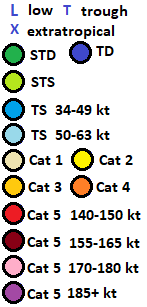Verification of tracks made of Polo
I made six tracks of Tropical Storm Polo, before it was
assessed as
a tropical cyclone. I made two more tracks after that point. Within 480
hours of cyclogenesis, there were two instances,
when I missed cyclogenesis entirely.
As of this analysis, best track positions are available November 12, 18Z
thru November 19, 18Z, and as such, position comparisons are possible only
for this timespan.
Since I give only SSHS categories in my tracks, I don't
calculate intensity errors in units of speed, but in categories. For
this purpose, I define tropical or subtropical storms as "Category 0", tropical
or subtropical depressions as "Category -1" and non-existence of a tropical or subtropical cyclone as
"Category -2".
In the six tracks (made before operationally recognized cyclogenesis),
formation times ranged between November 12, 00Z and November 19, 00Z. Average
was November 15, 18Z and median was November 15, 18Z.
In the nine cases (7 tracks, before the tracks and data agreed,
that tropical storm would remain the peak intensity, and 2 complete
misses), peak intensity ranged between Category -2 and Category 5.
Average was Category 0.67 and median was Category 0.
In the eight tracks (made before operationally recognized degeneration
into remnant low), dissipation times ranged between November 19, 06Z
and November 24, 06Z. Average was November 20, 23Z and median was November 20, 12Z.
At the lead time of 1 day (24 hours), there were 2 hits, 0 false detections and 0 misses. 2 available position comparisons produce an average error of 17 nautical miles.
At the lead time of 2 days (48 hours), there were 1 hit, 1 false detection and 1 miss. 1 available position comparison produces an average error of 56 nautical miles.
At the lead time of 3 days (72 hours), there were 0 hits, 1 false detection and 2 misses. No available position comparisons.
At the lead time of 4 days (96 hours), there were 1 hit, 2 false detections and 0 misses. 2 available position comparisons produce an average error of 164 nautical miles.
At the lead time of 5 days (120 hours), there were 0 hits, 1 false detection and 0 misses. 1 available position comparison produces an average error of 108 nautical miles.
At the lead time of 6 days (144 hours), there were 0 hits, 1 false detection and 0 misses. 1 available position comparison produces an average error of 136 nautical miles.
At the lead time of 7 days (168 hours), there were 1 hit, 1 false detection and 0 misses. 2 available position comparisons produce an average error of 214 nautical miles.
At the lead time of 8 days (192 hours), there were 1 hit, 2 false detections and 0 misses. 3 available position comparisons produce an average error of 320 nautical miles.
At the lead time of 9 days (216 hours), there were 2 hits, 0 false detections and 0 misses. 2 available position comparisons produce an average error of 239 nautical miles.
At the lead time of 10 days (240 hours), there were 2 hits, 0 false detections and 0 misses. 2 available position comparisons produce an average error of 318 nautical miles.
At the lead time of 11 days (264 hours), there were 0 hits, 2 false detections and 0 misses. 1 available position comparison produces an average error of 540 nautical miles.
At the lead time of 12 days (288 hours), there were 0 hit, 1 false detection and 0 misses. No available position comparisons.
At the lead time of 13 days (312 hours), there were 0 hits, 2 false detections and 0 misses. No available position comparisons.
At the lead time of 14 days (336 hours), there were 0 hits, 2 false detections and 0 misses. 1 available position comparison produces an average error of 253 nautical miles.
At the lead time of 15 days (360 hours), there were 0 hits, 1 false detection and 1 miss. 1 available position comparison produces an average error of 304 nautical miles.
At the lead time of 16 days (384 hours), there were 0 hits, 2 false detections and 1 miss. 2 available position comparisons produce an average error of 303 nautical miles.
At the lead time of 17 days (408 hours), there were 0 hits, 2 false detections and 0 misses. 2 available position comparisons produce an average error of 251 nautical miles.
At the lead time of 18 days (432 hours), there were 1 hit, 1 false detection and 0 misses. 2 available position comparison produces an average error of 260 nautical miles.
At the lead time of 19 days (456 hours), there were 1 hit, 0 false detections and 1 miss. 1 available position comparison produces an average error of 682 nautical miles.
At the lead time of 20 days (480 hours), there were 1 hit, 0 false detections and 0 misses. 1 available position comparison produces an average error of 894 nautical miles.
Circle coloration scheme
Here are the tracks once again.
October 30, 12Z:
October 31, 06Z:
November 8, 18Z:
November 9, 12Z:
November 11, 12Z:
November 15, 12Z:
November 17, 12Z:
November 18, 12Z:
The complete misses were from the following model cycles:
November 3, 06Z
November 16, 12Z









Comments
Post a Comment